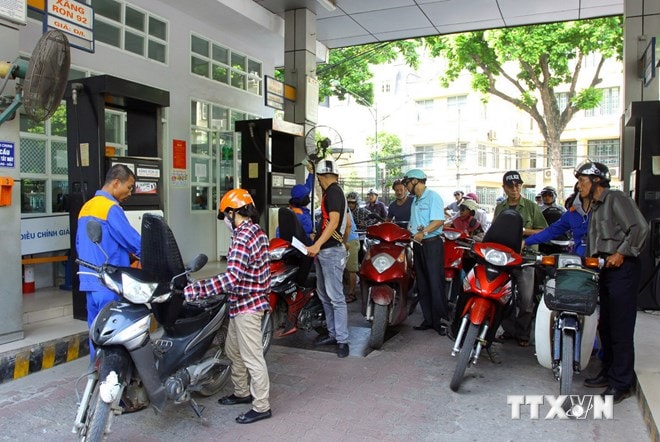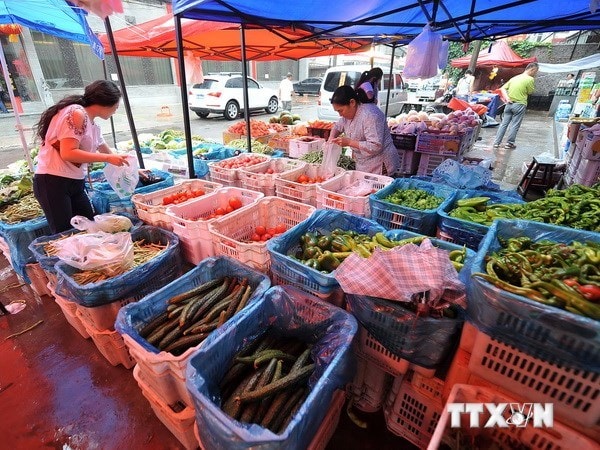Gasoline prices decreased 7 times, transportation fares and consumer goods prices remained unchanged
After the first week of gasoline price reduction, market prices did not decrease accordingly. This is in stark contrast to the situation where commodity prices usually increase every time gasoline prices increase.
On October 13, the Vietnam National Petroleum Group reduced gasoline prices by 670 VND/liter to 22,890 VND/liter, diesel prices by 880 VND/liter to 20,240 VND/liter, kerosene prices were rounded down to 850 VND/liter to 20,500 VND/liter... Thus, since the beginning of the year, this is the seventh time domestic gasoline prices have cooled down. Consumers still hope that the reduction in gasoline prices will reduce transportation costs and consumer prices. However, the reality is not like that.
 |
| Illustration photo: VNA |
No discount on transportation
In transportation, fuel accounts for about 40-50% of the cost factor. The continuous decrease in fuel prices in recent months is expected to reduce transportation costs.
However, according to Mr. Bui Danh Lien, Chairman of the Hanoi Transport Association, this reduction in gasoline prices will not affect transportation fares. Because although gasoline prices have decreased, the reduction in the price range in the last seven times is too low, not enough to compensate for the previous price increases, with one time only a reduction of 30 VND/liter. If businesses want to change fares, they will spend a lot of time and money on procedures for registering fare adjustments, changing fare meters, gift cards, tickets, etc. Therefore, fares cannot be adjusted down immediately when gasoline prices decrease.
According to Mr. Lien, transportation businesses adjust fares when the total increase/decrease in gasoline prices exceeds 7-10%. Although this is the seventh time gasoline prices have been reduced in the past two months, compared to the total price increases of the previous times, the total decrease in gasoline prices up to now is only about 700 VND/liter. Compared to the current gasoline price of 22,890 VND/liter, this difference only accounts for about 3%.
Furthermore, when gasoline prices increased sharply before, transport businesses also had to "struggle" to maintain fares to ensure competitiveness in the market. Meanwhile, other fare components such as bridges, roads, parking lots, insurance, periodic driver inspections; fees; salaries for staff... are also weighing on businesses. Therefore, the reductions in gasoline prices over the past two months will help transport businesses reduce the burden of input costs.
Sharing the same view, according to the Chairman of the Vietnam Automobile Transport Association Nguyen Van Thanh, fuel costs are considered one of many important factors that make up transportation fares. Since the beginning of the year, gasoline prices have decreased many times, but the reduction range is only 1-3%, so it is very difficult to immediately adjust fares down.
Furthermore, in reality, whenever transport fares want to be reduced, there must be a certain delay, because the procedures and costs for adjusting the reduction are also complicated, and businesses also need time to monitor the fluctuations in gasoline prices, whether they will increase again or not. In calculating the increase/decrease in prices, taxi businesses will encounter more difficulties due to costs such as reprinting fares, adjusting meters, registering with authorities, etc. Therefore, there must be a long-term reduction margin for transport businesses to be able to make adjustments.
 |
| Prices of food items remain the same as before the petrol price reduction. Source: VNA |
Consumption still holds prices
Not only have transportation costs remained the same, but essential consumer goods have also not fluctuated when gasoline prices have decreased. Surveyed at Hom market (Hanoi) on October 19, the prices of vegetables have remained the same as in previous weeks. Specifically, green mustard greens are 5,000 VND/bunch, tomatoes are 12,000 VND/kg, squash is 10,000 VND/kg... Particularly, water spinach has increased by 2,000 VND/bunch, being sold for 15,000 VND/bunch; potatoes are 15,000 VND/kg, a slight increase of 1,000 VND...
Prices of meat and fish products have also remained the same as before the gasoline price reduction. Lean pork loin, lean pork rump and pork ribs cost from 95,000-110,000 VND/kg; Beef, fish and shrimp prices remain stable, such as beef at 240,000 VND/kg; carp at 70,000-80,000 VND/kg; tilapia at 55,000 VND/kg...
According to traders at Hom Market, the decrease in gasoline prices has no impact on the selling prices of consumer products. The price increase/decrease mainly depends on consumer demand and the supply of goods during the day.
Mr. Vu Vinh Phu, Chairman of the Hanoi Supermarket Association, said that in markets and supermarkets, most items have not been discounted. Gasoline prices continue to decrease but so far have not had much impact on the market, essential goods still maintain prices due to seasonality and consumer psychology.
This is a paradox because according to Mr. Phu, the price of food and vegetables depends on many factors such as supply, weather, season, etc., but the price of gasoline still affects about 10% of the cost. In order for people not to have to bear the current stagnant consumer prices, managers can come up with solutions to stabilize prices and implement social security in the coming time.
According to Vietnam+






